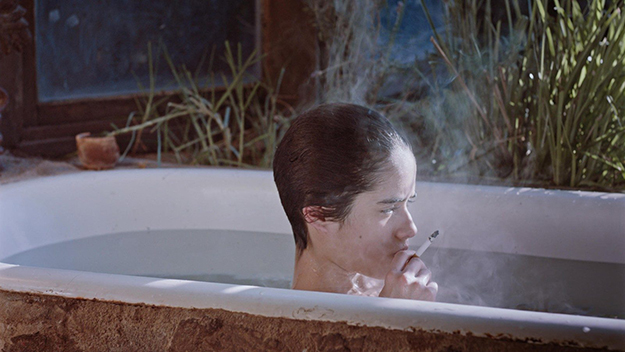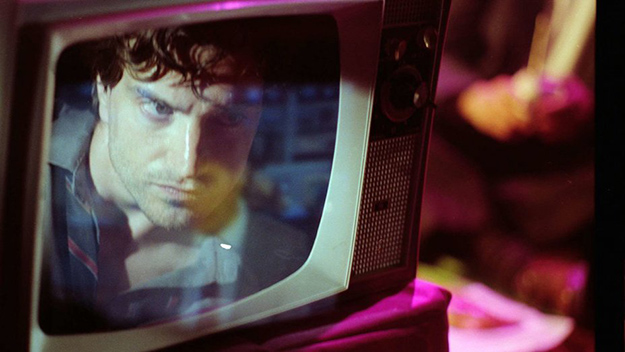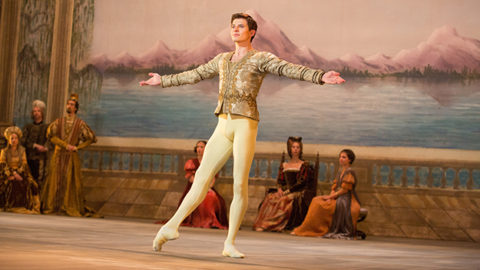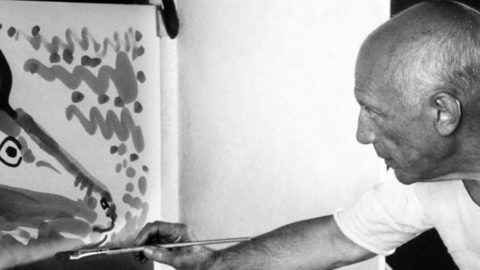In the Moment: Too Late to Die Young and The Wandering Soap Opera

Too Late to Die Young (Dominga Sotomayor, 2018)
Dominga Sotomayor describes her film Too Late to Die Young as “a memory in the present tense.” The seed of the film—or the spark, one might say—came from a rediscovered VHS tape with footage of a wildfire that broke out on New Year’s Day, 1990, in an off-the-grid community in the hills above Santiago, Chile, where the director was then a 5-year-old living with her family. Around this event, Sotomayor creates a portrait, at once vivid and diffuse, of a group of people, a moment in time, and a stage of life. In December 1989, Chile’s long-time dictator Augusto Pinochet was ousted from power by democratic elections, but the film deliberately avoids explicit references to this historical context. Instead, it is present in the background, through the focus on in-betweenness—the transitional state of adolescence, the lulls of time separating events—and a mood that is idyllic and celebratory but tinged with confusion, loss, and uncertainty.
At the center of the film is Sofia (Demian Hernández), a 16-year-old girl living with her father, a taciturn luthier. Her absent mother is pursuing a career as a singer in Santiago, and Sofia nurses a dream of going to live with her, perhaps to escape the insularity and familial embrace of the small, artsy-hippie community. Her main interests in life seem to be smoking cigarettes and pursuing an attractive older man, Ignacio (Matías Oviedo), to the dismay of her pining friend, the sensitive, guitar-strumming Lucas (Antar Machado). She broods in the bathtub, and has a self-harming habit of scratching raw patches on her hands. Hernández is beautiful to watch—gawky, gazelle-like, able to turn on a dime from nervous and sullen to shyly radiant. Sofia is unformed, in a manner typical of her age, and also somewhat opaque; the film’s impressionistic style gives you the feeling of being a bystander, present on the scene but without access to people’s inner lives. More is communicated through glances and exchanged looks than through words. Lovely shots through the sun-gilded dust of a car windshield, or through smoke that delineates shafts of light, convey a beauty in what is half-seen, what is unclear.
Relationships and tensions are revealed in the buildup to a New Year’s Eve party, which is followed by the outbreak of fire the next day. We get to know the community, with its long-haired women and scruffy-bearded men, its handcrafted wooden houses and endless picnics. It is a fragile paradise, subsisting without electricity. There are moments of exquisite grace—a man playing the cello in a room lit by candles, the camera rising with the sound into the high, dark rafters—but also hints of discord. There is a break-in, a mysterious sabotage of a water-hose, a drunken fight in town. Ten-year-old Clara (Magdalena Tótoro) searches for her lost dog, Frieda, and in one of the most pointed scenes, a man claims to have seen their pet and leads them to a house in a slum neighborhood. There, her parents hand over some money for a look-alike dog that Clara gradually comes to suspect is not really hers—an uncomfortable demonstration of privilege seen through a child’s eyes. Loose ends and a certain organic messiness are intentional: Sotomayor has said she wanted to capture “the way we remember things,” some moments inexplicably preserved and others vague or distorted.
More and more movies seem devoted primarily to re-creating the past. The attention lavished on period detail can sometimes feel showy, and efforts to give a distinct look to earlier eras—often through digital manipulation of color to create a de-saturated or sepia-toned effect—can be jarring because contemporary technology is so glaringly evident in the image. Too Late to Die Young never feels false, overdone, or calculating. Much of the time, it resembles actual home movies—exceptionally well-made ones—both in the sun-bleached, soft images and the loose, fragmentary structure, which seems to capture snippets of life going on. There is always a scrum of children running around, playing on dirt bikes and tire swings, adults in the background tinkering with cars or their jury-rigged water system. People picnic, swim, chit-chat, eat, and drink. It could any time, it could be today—yet there is an overwhelming sense of looking into the past, perhaps because of the reminders that everything can, and will, be swept away.
Joanna Hogg’s The Souvenir is another example of autobiographical filmmaking with an obsessive attention to resurrecting the past: the main character’s apartment, and the view outside the window, are meticulous copies of Hogg’s London home in the early 1980s. Real letters, contemporary photographs, and Super 8 film footage are incorporated into the film, which is based on the director’s early adulthood and a relationship she had with a troubled older man. A debate runs through the film about the proper aims of moviemaking, with Anthony (Tom Burke) challenging the ideas of Julie (Honor Swinton Byrne), a young film student from a well-to-do background who is drawn to documenting the impoverished, decaying industrial port city of Sunderland. In a movie, we don’t just want to see life as it is, Anthony says, we want to see it as it is experienced “within this soft machine.” He questions whether sincerity is enough, whether honesty should be an end in itself. “We can all be honest, we can all be authentic, but what’s it all for?” He wins the argument by citing Powell and Pressburger, whose films are “truthful without being real.” In a recent New Yorker profile, Hogg reflects on the period of her life depicted in The Souvenir: “That phase was very much about me being a protagonist in a production, in a way . . . Rather than make my own films when I was with him, I was in a film, a Hitchcock film that had a lot of mystery and intrigue.”

The Wandering Soap Opera (Raúl Ruiz, 1990/2017)
In The Wandering Soap Opera, an experimental feature shot by Raúl Ruiz in 1990 and completed and completed by his wife Valeria Sarmiento in 2017, everyone is starring in a different soap opera. A series of absurdist vignettes that combine parody of telenovela styles and conventions with pure dada, the film was made during a six-day directing workshop in Chile, at exactly the same moment that Too Late to Die Young is set, in the aftermath of the Pinochet regime. While the improvisational film is filled with mordant references to Chile’s political and cultural situation, it feels prescient in the way its characters are constantly aware of being watched. The opening episode is titled “People Are Watching,” a line that keeps recurring throughout the scene. What starts out as a hilarious, pitch-perfect soap-opera parody, with an older man crassly wooing his younger lover, turns surreal when he boasts about his muscles and demonstrates by pulling slabs of raw meat from his pockets and plunking them into her hands (meat is nothing but muscle, he explains to the surprised woman). Other episodes spoof political assassination thrillers, with a rapidly multiplying body count; a banal office drama in which a man conducts a mind-numbing phone conversation while a secretary plucks hairs from his palms; an Arcadian melodrama in which a group of women, realizing their husbands have vanished, ecstatically embrace a new life together. Filled with wordplay, bizarre exchanges, and dark prophecies, the episodes become progressively more dreamlike and mysterious, shading from comedy to something ominous and poetic.
The Wandering Soap Opera was pieced together from several prints, a making-of documentary, and the director’s notes (as detailed by Galut Alarcón in Film Comment‘s May/June 2019 issue). The film expressed Ruiz’s reaction on returning to Chile after years in exile: “Its structure is based on the assumption that Chilean reality does not exist . . . The political and economic problems are immersed in a fictional jelly.” It is this fictional jelly that makes the project feel like something that could be made today: the sense that everyone is continually aware of performing for others, and that everything is filtered through bubbles of artificial drama, none of which make any sense or have any purpose. The people we see on screen are always watching television (in one episode, a woman on a couch explains, “Nothing happens in this soap opera. We just watch other soap operas and comment on them”), but the people on the TVs are also watching the audience. Everyone watching and being watched, consuming and being consumed, too immersed to wonder what any of it means.
Imogen Sara Smith is the author of In Lonely Places: Film Noir Beyond the City and Buster Keaton: The Persistence of Comedy, and has written for The Criterion Collection and elsewhere. Phantom Light is her regular column for Film Comment.







